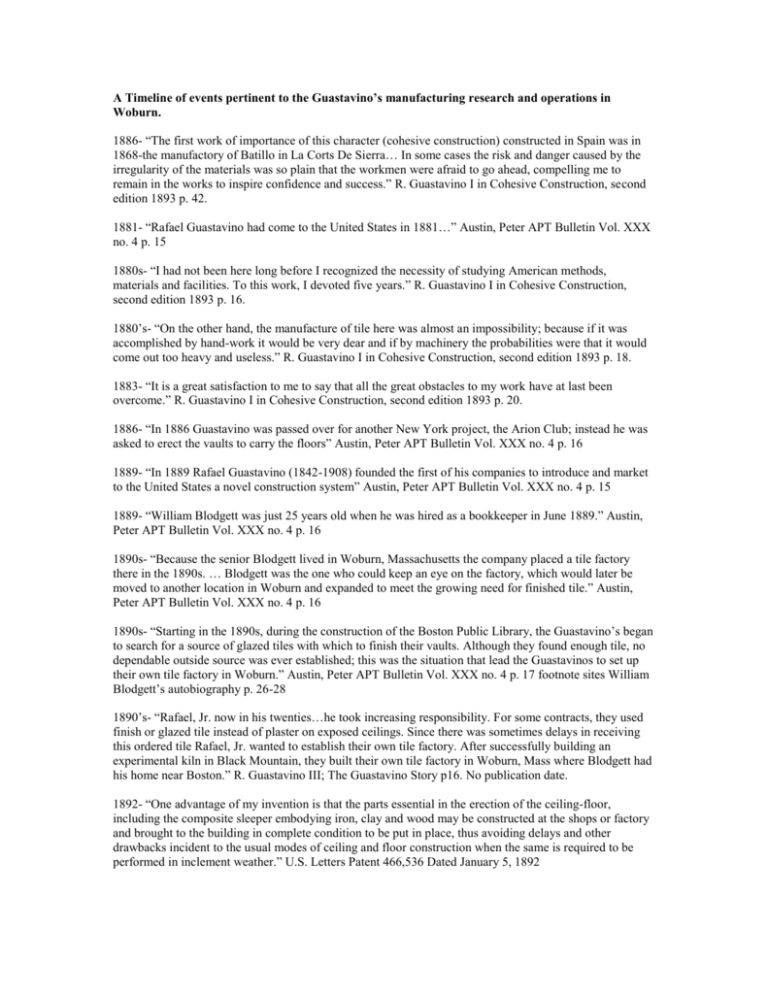Timeline of events pertinent to the Guastavino operations in
advertisement

A Timeline of events pertinent to the Guastavino’s manufacturing research and operations in Woburn. 1886- “The first work of importance of this character (cohesive construction) constructed in Spain was in 1868-the manufactory of Batillo in La Corts De Sierra… In some cases the risk and danger caused by the irregularity of the materials was so plain that the workmen were afraid to go ahead, compelling me to remain in the works to inspire confidence and success.” R. Guastavino I in Cohesive Construction, second edition 1893 p. 42. 1881- “Rafael Guastavino had come to the United States in 1881…” Austin, Peter APT Bulletin Vol. XXX no. 4 p. 15 1880s- “I had not been here long before I recognized the necessity of studying American methods, materials and facilities. To this work, I devoted five years.” R. Guastavino I in Cohesive Construction, second edition 1893 p. 16. 1880’s- “On the other hand, the manufacture of tile here was almost an impossibility; because if it was accomplished by hand-work it would be very dear and if by machinery the probabilities were that it would come out too heavy and useless.” R. Guastavino I in Cohesive Construction, second edition 1893 p. 18. 1883- “It is a great satisfaction to me to say that all the great obstacles to my work have at last been overcome.” R. Guastavino I in Cohesive Construction, second edition 1893 p. 20. 1886- “In 1886 Guastavino was passed over for another New York project, the Arion Club; instead he was asked to erect the vaults to carry the floors” Austin, Peter APT Bulletin Vol. XXX no. 4 p. 16 1889- “In 1889 Rafael Guastavino (1842-1908) founded the first of his companies to introduce and market to the United States a novel construction system” Austin, Peter APT Bulletin Vol. XXX no. 4 p. 15 1889- “William Blodgett was just 25 years old when he was hired as a bookkeeper in June 1889.” Austin, Peter APT Bulletin Vol. XXX no. 4 p. 16 1890s- “Because the senior Blodgett lived in Woburn, Massachusetts the company placed a tile factory there in the 1890s. … Blodgett was the one who could keep an eye on the factory, which would later be moved to another location in Woburn and expanded to meet the growing need for finished tile.” Austin, Peter APT Bulletin Vol. XXX no. 4 p. 16 1890s- “Starting in the 1890s, during the construction of the Boston Public Library, the Guastavino’s began to search for a source of glazed tiles with which to finish their vaults. Although they found enough tile, no dependable outside source was ever established; this was the situation that lead the Guastavinos to set up their own tile factory in Woburn.” Austin, Peter APT Bulletin Vol. XXX no. 4 p. 17 footnote sites William Blodgett’s autobiography p. 26-28 1890’s- “Rafael, Jr. now in his twenties…he took increasing responsibility. For some contracts, they used finish or glazed tile instead of plaster on exposed ceilings. Since there was sometimes delays in receiving this ordered tile Rafael, Jr. wanted to establish their own tile factory. After successfully building an experimental kiln in Black Mountain, they built their own tile factory in Woburn, Mass where Blodgett had his home near Boston.” R. Guastavino III; The Guastavino Story p16. No publication date. 1892- “One advantage of my invention is that the parts essential in the erection of the ceiling-floor, including the composite sleeper embodying iron, clay and wood may be constructed at the shops or factory and brought to the building in complete condition to be put in place, thus avoiding delays and other drawbacks incident to the usual modes of ceiling and floor construction when the same is required to be performed in inclement weather.” U.S. Letters Patent 466,536 Dated January 5, 1892 1893- “It may be remarked that a great deal still has to be accomplished by way of improvement, and it is necessary to call for assistance in perfecting our knowledge of the art of building, especially from the manufacturers of materials and architects.” R. Guastavino I in Cohesive Construction, second edition 1893 p. 144 1899- Kiln Patent applied for “Signed at New York, this the 12th day of May, 1899 –RAFAEL GUASTAVINO” U.S. Letters Patent 670,777 Dated March 26, 1901 1900-“About seven years ago the company made an experimental start in making its own tile in what was formerly the old wooden St. Charles Church along the railroad between Green and Fowle streets.” Woburn Daily Times June 18, 1907 1900- “At the turn of the century, Mr. Guastavino, Jr., after some studies encouraged by the company treasurer, Mr. Blodgett, Sr. had set up a factory in Woburn, Mass. for the manufacture of soffit tile. This highly desirable step was taken because they had found that obtaining commercially the special orders for their contracts on time was extremely difficult.” George Collins Forward to The Guastavino Story by R. Guastavino III, p4. No publication date. 1901-“The fullest and most complete source of information is the factory order cards, which record in detail each order of tile from the factory in Woburn, Massachusetts beginning April 27, 1901… The (Woburn) Factory commenced production, hence the files do not record the first decade or so of activity” Parks, Janet APT Bulletin Vol. XXX no. 4p. 22 1901- Kiln Patent granted U.S. Letters Patent 670,777 Dated March 26, 1901 1901- In reference to the Buffalo General Hospital… “All the enameled tiles used are made at the factory of the R/ Guastavino Company at Woburn, Mass., and are the result of much expensive experimentation in burning enameled tiles without saggers, by which process it has been possible to make large quantities of tile in less time than formerly.” By Peter Wright in The Brickbuilder 10 p.187 1907- “La Ceramica, the new tile plant of the R. Guastavino Company, in Central Square was duly dedicated to its purposes and visited by a large number of representative citizens between two o’clock and ten p.m.” Woburn Daily Times June 18, 1907 1912- “50-ACRE LAND PURCHASE BY THE R. GUASTAVINO CO.” Woburn Daily Times April 18, 1912 1915- “State Police are investigating several unexplained features of the fire that caused $50,000 damage to the supposedly-fire-proof R. Guastavino Tile Company factory at Central Square at 1 o’clock Sunday morning.” Woburn Daily Times June 1, 1915 1915- “…I am writing this letter, comparing some of the published statements with the actual facts. … Reconstruction began the next day. None of our men lost a day’s worth of work. There has been practically no stoppage of our manufacture.” Letter to the editor from W.E. Blodgett in the Woburn Daily Times June 4, 1915 1940s-“The Guastavino Company manufactured tile in Woburn since 1906 in a factory at 660 Main Street and the company offices were consolidated and moved there in the 1940s, notes Judity Leynse, the Association Director of Columbia University.” DTC May 3, 1996




